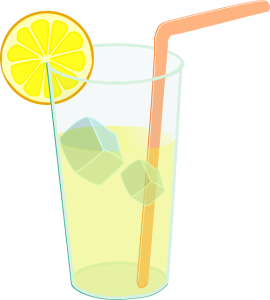Navigating this Pathway
[stextbox id = “info”] This pathway poses a question to students: Why is there liquid on the outside of a glass of water? We recommend having students write the question in their science notebook and/or displaying this driving question prominently in the classroom throughout the pathway. Students begin by observing a glass of ice water and explaining where they think the liquid on the outside of the glass came from. Next, students observe a glass of a cold opaque liquid (e.g., iced tea, soda, Kool-Aid) and explain the liquid on the outside of that glass. This second example challenges students who believe the liquid on the outside of the glass came from the inside. The students then draw pictures of the air around the glass of ice water using “super strong glasses,” more powerful than the strongest microscope. Next, students engage with a demonstration in which an ice pack is removed from a freezer and weighed on a scale every five minutes for 25 minutes total and note that the weight increases over time. An optional demonstration involves placing a warm and cold can of soda in front of a humidifier to observe the condensation on each. Students then engage with a computer simulation of particles in the solid, liquid, and gas phases to gain a better understanding of condensation in relation to the particle model. Finally, students revisit their super strong glasses drawings and revise using their emerging understanding of the particle nature of matter.[/stextbox]
Connections to Other Pathways
[stextbox id = “info”] Students tend to have a more difficult time understanding the process of condensation compared with evaporation, melting, or freezing (Aydeniz & Kotowski, 2012; Nakhleh, Samarapungavan, & Saglam, 2005). One possible explanation for this is that students cannot see water vapor in the air so it can be a challenge for them to understand where the condensed water comes from. For this reason, it may be best to complete this pathway after students have engaged with others and have a sense about the particle model of matter.[/stextbox]
Teacher Content Background
[stextbox id = “info”] All matter is made of particles that are too small to see, that are in constant random motion, and that have empty space between them. “Empty space” is literally empty; that is, nothing at all is between the particles that make up matter. All particles in one state are still present even after matter has changed states; no particles are added or destroyed. In addition, the size and shape of the particles does not change. Therefore matter (and mass, or weight) is conserved (stays the same) during phase change because all of the particles present in one state are present in the other (no more and no less).Condensation occurs when the water particles in air come in contact with a cool liquid or solid surface. The water particles slow down and stick together, forming water droplets.
[/stextbox]
Student Thinking
[stextbox id = “info”]- Water on the outside of a cold glass is caused by a leakage of water or seepage of cold from inside the glass (Osborne & Cosgrove, 1983; Prain et al., 2009)
- An unseen layer of ice melts and leaves drops of water on the outside of a cold surface (Papageorgiou & Johnson, 2005)
- Water forms as a reaction between a cold surface and dry air (Osborne & Cosgrove, 1983)
- Condensation is caused by steam combining with air (Aydeniz & Kotowski, 2012)
Student Experiences
[stextbox id = “info”]- Student Experience 1: Liquid on the Outside of a Glass (Part A)
Students observe and discuss the liquid on the outside of a glass of cold water. - Student Experience 2: Liquid on the Outside of a Glass (Part B)
Students observe and discuss the liquid on the outside of a glass of something other than water. - Student Experience 3: Imagining Particles, Part 1
Students imagine what they would see with “super strong glasses” when observing condensation. - Student Experience 4: Weighing a Frozen Object
Students apply their emerging understanding of condensation to a new situation. - Student Experience 5: (Optional) Soda Cans and a Humidifier
Students apply their emerging understanding of condensation to a new situation. - Student Experience 6: States of Matter Simulation
Students observe phase change using a computer simulation. - Student Experience 7: Imagining Particles, Part 2
Students revisit their super strong glasses drawings and revise using their new understanding.
